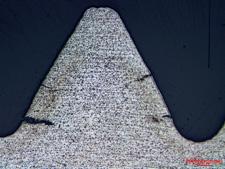
2 minute read
Look For The Simple Things
Source: Fortescue Metals Group
The following short investigation shows that events may not be as complicated as they first seem, and that it is sometimes the simple things that go wrong.
A broken M26 bolt was received, from Fortescue Metals Group, for examination into the cause and mode of its failure. It was reported that the material was a 16MnCr5 low alloy steel.
The bolt was found to have failed at the first thread, and an area of fatigue was visible on the fracture faces, while the rest of the fracture had sustained post fracture damage. The area of fatigue covered about a quarter of the fracture surface. The small area of fatigue, compared to the rest of the fracture, indicates that the bolt was under a high stress for the bolt material.
Transverse cracking was observed at the threads roots and this was consistent with secondary fatigue cracking. On the opposite side of the bolt from the fatigue, cracking on both sides of the thread flanks was found. This indicates that loading on the bolt could have exceeded the material strength. The microstructure was seen to be ferrite and pearlite and the threads had been machined.
The chemical analysis of the bolt showed that it met the requirements of a 16MnCr5 low alloy steel. In the annealed condition, such a steel has a hardness of 147 – 187HB (1). The hardness of the bolt under investigation was measured to be 160HB giving a UTS of 540MPa (2) and demonstrates, with the microstructure of ferrite and pearlite, that the material was in the annealed condition.
However, when heat treated by quenching and tempering, a UTS of >900MPa is obtainable (1). Such a material strength would greatly increase the fatigue life and stop the thread cracking seen in the present investigation. It was therefore considered that the bolt had not been given the correct heat treatment to obtain the full mechanical properties that the material was capable of attaining.
Top: The as received bolt showing failure at the first thread. Middle: Fracture face showing a small crescent of fatigue and the rest of the face suffering from post fracture damage. Bottom left: Microsection showing secondary fatigue cracking at the roots of the machined threads. Bottom right: Microsection showing cracking on the flanks of the threads.

ISO 9001 :2015 Certified













